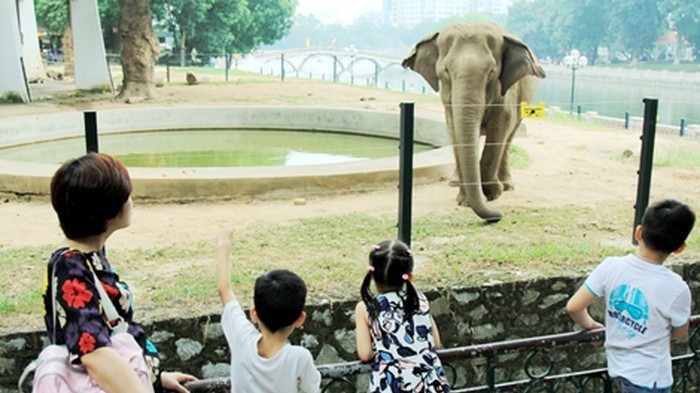
Hanoi Zoo, in Ba Dinh district, Hanoi, was recognised as a tourist site according to a recent decision approved by the Hanoi city People’s Committee.

Children watching an elephant at the zoo
The decision also announced that Hanoi Zoo Co. Ltd has
responsibilities to manage and develop the site in accordance with the Law on
Tourism and related legal documents.
Established in 1976, Hanoi Zoo, also
known as Thu Le Park, covers around 29 hectares in Ngoc Khanh ward.
It is home to 600 individuals of over
100 species including amphibians, saltwater fishes, mammals, and birds. More
than 40 species among them are endemic species which are listed in the
Vietnam’s Red Book, such as the Asian golden cat, Indochinese tiger, leopard,
and Vietnamese fireback.
Hanoi Zoo joined the South East Asian
Zoos Association in 1993 and has expanded its cooperation with many zoos and
other wildlife conservation organisations around the world.
It
opens for the public from 8:00 to 18:00 every day, with an entrance fee of
VND10,000 for adults and VND5,000 for children.
Source: NDO
Nestled at the foot of a mountain with the serene Sia stream flowing by, Hich 2 village in Mai Hich commune, Mai Chau district, offers a tranquil retreat and an authentic cultural experience of the Thai ethnic community. Known for its unspoiled nature and preserved traditions, it has become a favourite destination for international tourists.
The People’s Committee of Tan Lac district recently hosted a cultural, sports and tourism festival of local highland communes and a ceremony to receive the Heritage Tree designation.
Hien Luong commune in Da Bac district is blessed with beautiful landscapes, thanks to its location besides a vast, picturesque reservoir with clear waters year-round. This natural advantage has allowed the local ethnic minorities to develop sustainable tourism, becoming a community tourism destination.
The 2024 Tour Guide Competition was held in the framework of the Hoa Binh Provincial Culture and Tourism Week, bringing together 13 contestants from seven districts and cities to celebrate the vital role of tour guides as cultural ambassadors.



